HERSTORY


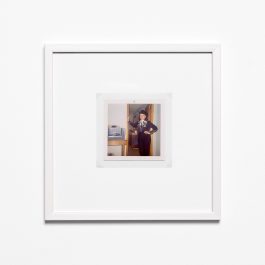

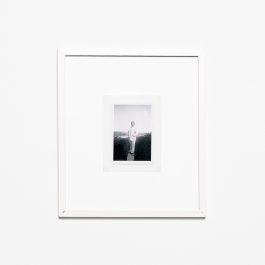

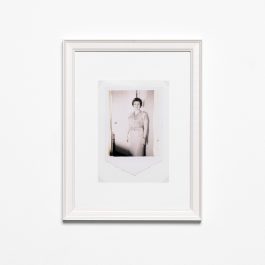
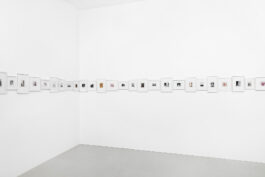
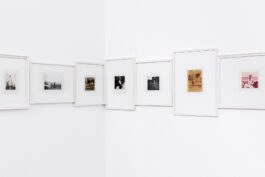
HERSTORY
2010 – 2020
78 individually framed photographic reproductions
black & white and color
C-Prints, photo corners, paper
Frame sizes 17 × 14 cm to 37 × 28 cm
The installation is 18 m long
The installation gathers selected photographic portraits of women from the 1920s to the 1970s that I collected in Williamsburg, Brooklyn. With its Polish, Russian, Hispanic and Jewish communities, Williamsburg is one of the most gentrified districts of New York City.
The color and black-and-white photographs show women in ordinary surroundings, positioned centrally in the picture, their gaze turned towards the camera. I reproduced the amateur photographs photographically true to the original and mounted them in found, uniformly painted frames. In the installation, these are arranged edge to edge like a sound-wave line.
In Herstory I follow the idea of whose story is usually overlooked in conventional historiography. I examine these contemporary documents in terms of the pose presented in the picture. I investigate what they say about social perceptions of gender roles and to what extent the emergence and popularization of amateur photography has influenced the staging of "femininity".
78 individuell gerahmte fotografische Reproduktionen
Schwarz-Weiß und Farbe
C-Prints, Fotoecken, Papier
Rahmengrößen 17 x 14 cm bis 37 x 28 cm
Die Installation ist 18 m lang
Die Arbeit versammelt ausgewählte fotografische Frauenportraits der 1920er bis 1970er Jahre, die ich aus Trödelläden in Williamsburg, Brooklyn zusammengetragen habe. Williamsburg gehört mit seinen polnischen, russischen, lateinamerikanischen und jüdischen Communities zu den am stärksten gentrifizierten Stadtteilen von New York City.
Die Farb- und Schwarz-Weiss Aufnahmen zeigen Frauen in alltäglicher Umgebung, zentral im Bild positioniert, ihren Blick der Kamera zugewandt. Die Amateurfotografien habe ich fotografisch originalgetreu reproduziert und in gefundene, einheitlich lackierte Rahmen gefasst. In der Installation sind diese Kante an Kante als schallwellenförmige Linie angeordnet.
In Herstory folge ich der Überlegung, wessen Geschichte in herkömmlicher Geschichtsschreibung meist übersehen wird. Ich untersuche die Zeitdokumente in Hinblick auf im Bild präsentierte Posen und gehe der Frage nach, was sie über gesellschaftliche Geschlechtervorstellungen und Rollenverständnisse aussagen. Inwiefern hatte das Aufkommen und die Verbreitung der Amateurfotografie Einfluss auf die Inszenierung von „Weiblichkeit“?
HERSTORY









HERSTORY
2010 – 2020
78 individually framed photographic reproductions
black & white and color
C-Prints, photo corners, paper
Frame sizes 17 × 14 cm to 37 × 28 cm
The installation is 18 m long
The installation gathers selected photographic portraits of women from the 1920s to the 1970s that I collected in Williamsburg, Brooklyn. With its Polish, Russian, Hispanic and Jewish communities, Williamsburg is one of the most gentrified districts of New York City.
The color and black-and-white photographs show women in ordinary surroundings, positioned centrally in the picture, their gaze turned towards the camera. I reproduced the amateur photographs photographically true to the original and mounted them in found, uniformly painted frames. In the installation, these are arranged edge to edge like a sound-wave line.
In Herstory I follow the idea of whose story is usually overlooked in conventional historiography. I examine these contemporary documents in terms of the pose presented in the picture. I investigate what they say about social perceptions of gender roles and to what extent the emergence and popularization of amateur photography has influenced the staging of "femininity".
78 individuell gerahmte fotografische Reproduktionen
Schwarz-Weiß und Farbe
C-Prints, Fotoecken, Papier
Rahmengrößen 17 x 14 cm bis 37 x 28 cm
Die Installation ist 18 m lang
Die Arbeit versammelt ausgewählte fotografische Frauenportraits der 1920er bis 1970er Jahre, die ich aus Trödelläden in Williamsburg, Brooklyn zusammengetragen habe. Williamsburg gehört mit seinen polnischen, russischen, lateinamerikanischen und jüdischen Communities zu den am stärksten gentrifizierten Stadtteilen von New York City.
Die Farb- und Schwarz-Weiss Aufnahmen zeigen Frauen in alltäglicher Umgebung, zentral im Bild positioniert, ihren Blick der Kamera zugewandt. Die Amateurfotografien habe ich fotografisch originalgetreu reproduziert und in gefundene, einheitlich lackierte Rahmen gefasst. In der Installation sind diese Kante an Kante als schallwellenförmige Linie angeordnet.
In Herstory folge ich der Überlegung, wessen Geschichte in herkömmlicher Geschichtsschreibung meist übersehen wird. Ich untersuche die Zeitdokumente in Hinblick auf im Bild präsentierte Posen und gehe der Frage nach, was sie über gesellschaftliche Geschlechtervorstellungen und Rollenverständnisse aussagen. Inwiefern hatte das Aufkommen und die Verbreitung der Amateurfotografie Einfluss auf die Inszenierung von „Weiblichkeit“?